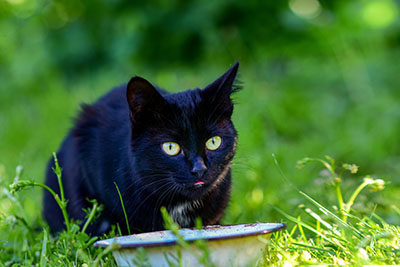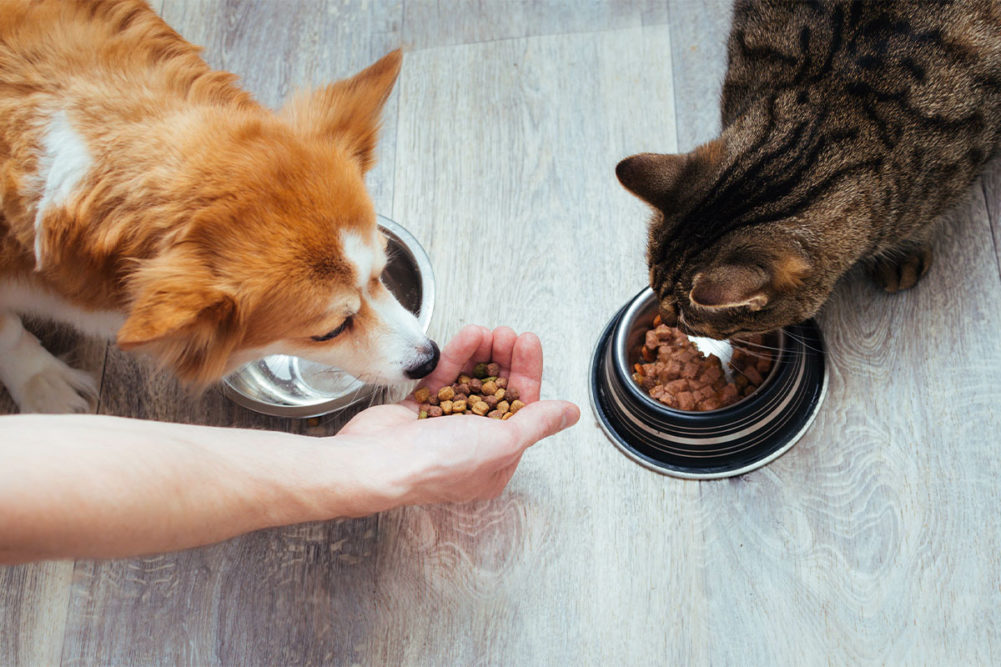ORLANDO, FLA. — During its “The State of Pet: What’s Next and What’s Trending in 2023” presentation, NielsenIQ shared its latest pet industry research at Global Pet Expo from March 22 to 24 in Orlando. Representatives from the market research firm dove deep into market growth, the latest consumer insights, sustainability trends and more.
Market growth
Kicking off the presentation, Andrea Binder, vice president of retail account development at NielsenIQ, highlighted the pet food industry’s volume and growth throughout the globe.
For the year ended Dec. 4, 2022, Europe and North America remain top dog in dog and cat food volume, reaching 5.7 billion equivalent (EQ) units and 5.6 EQ units, respectively. Though Europe holds the largest volume, the region experienced no growth in volume, decreasing 0.7% from the prior year, whereas North America increased 0.3%.
Latin America experienced the most volume growth at 4.8%, amassing 866 million EQ units. Asia also witnessed large growth, increasing 2.9% to 186 million EQ units. Africa was the only region to experience a drastic growth decline, decreasing 4.5% to reach 144 million EQ units of volume of dog and cat food.
“If we look at a global snapshot that [NielsenIQ] did over the last year, what we're able to see is that in dog and cat food, North America and Europe are really the drivers of volume,” Binder revealed. “But growth has been pretty stable, if not declining in Europe over the last year. When we look at where the growth is coming from, although on smaller scale, we see Asia and Latin America and especially driving some of the growth in the pet food space.”
Shifting focus to the entire pet care industry, Binder shared that the industry continues to be driven by both in-store and online retailers, also called omni sales. According to NielsenIQ Discover Omnisales, the US pet care industry amassed $77.5 billion in 2022, a 13.4% increase from 2021. Thirty-eight percent of these sales came from online-only retailers, an 18.8% increase from 2021, and 62% of these came from in-store only sales, a 10.2% increase from 2021. Though in-store continues to generate the majority of sales, online dollar share is steadily increasing, according to NielsenIQ, gaining 1.8 points in 2022.
With this growth in mind, Binder compared the pet care industry’s growth to that of other industries, including human food, gen merch, health and beauty and other consumer goods industries, revealing that pet care has grown 10.2% in-store and 18.8% online in 2022.
“[Pet care is] the second fastest growing department in both [in-store and online] segments,” she added. “In-store it's only being outpaced by human food and online it’s only being outpaced by household care. Otherwise, those growth rates of 10% and nearly 19% are significantly higher than some of the other departments across the store.”
Additionally, the majority of pet care segments are experiencing faster growth online than in-store, according to Binder.
“Nearly all categories are growing online faster than they are in stores,” she said.
These categories include dog treats and cat treats, dry and wet dog and cat foods, assorted foods and other pet food products.
While the industry continues to see growth, Binder explained that the growth is mostly being driven by inflationary pressure and not units sold. In December 2022, the US pet retail industry witnessed a 4.9% increase in dollar growth, however the unit volume decreased 9.4% during the same month. As consumers experience rising costs on their pet care products, many have taken to trading across the category to help cut down on their spending.
Binder showcased this trend, highlighting the change in share throughout private-label, premium, middle and value pet food products in the year ended February 2023. Dry dog food witnessed a 0.4% category share decline in the premium segment, whereas private-label and value dry dog foods increased 0.4% and 0.1% in share, respectively. On the other hand, wet dog food experienced share increases of 1.9% and 0.3% in both the middle and private-label segments. Dry cat food experienced minimal trading throughout the private-label, premium, middle and value sectors, however private-label wet cat food decreased the most in share at 1.5%.
Consumer insights
Sam Smith, associate client director at NielsenIQ, detailed the latest consumer trends amidst the industry’s continued growth.
According to NielsenIQ, 110.6 million households purchased pet care products in 2022, a nearly 2% increase from a year ago. Value per buyer has increase 10.7% in 2022 to $680. There are approximately 60.2 million households that purchased dog products and 36.9 million that purchased cat products. Though there are less cat-owning households throughout the United States, these households have a higher value per buyer at $986, an increase of 12% in 2021, whereas dog-owning households have a $899 value per buyer, an increase of 11.3%.
“Households are spending more whether they're going for products like freeze dried or natural or frozen that have a higher price tag,” Smith detailed. “The whole industry is spending more; households are spending more.”
 Source: ©ANDRIY BLOKHIN - STOCK.ADOBE.COM
Source: ©ANDRIY BLOKHIN - STOCK.ADOBE.COM
Within the omnichannel space, Smith shared that pet food omni shoppers drove the most dollar growth within the entire US pet nutrition industry in 2022. In-store only households still remain king, accounting for 56.1% of all US pet food purchasing households, though they experienced a 4.0% decrease from 2021. Online only shoppers maintain a measly share of 2.9% of total US pet food buyers, a decrease of 2.2%. Omni households offer the largest opportunities for pet care brands, accounting for 41.0% of all pet food purchasing households, an increase of 6.2%.
In dollar share, in-store accounted for 35.9% of total US pet food dollar share, a large decline of 7.1% in 2022. Online only accounted for a measly 3.0% of total dollar share, a decrease of 4.1%. Omnichannel only continued to grow, accounting for 61.1% of total US pet food dollar share, an increase of nearly 5% from 2021.
“[Omnichannel] truly is the space that needs to be played in,” Smith explained. “You’re going have households that want to buy in-store for certain needs, and you’re going to have households that want to set it and forget it and buy online for certain needs. These households are extremely valuable.
“These are the households that are very important for the pet care space and they're going to continue to grow as people continue to adopt the Omni type of mentality,” he added.
Fueling the growth in omnichannel are consumer pickup and direct-delivery shipping methods. According to Smith, heavy pet food products, like dry and wet dog food, experienced stronger growth in consumer pickup and lighter products, like dog and cat treats, and dry and wet cat food, experienced stronger growth in being shipped directly to consumers.
Sustainability trends
Lastly, Sherry Frey, vice president of total wellness at NielsenIQ, shared the latest sustainability trends and consumer insights within the pet care industry. According to Frey, sustainability attributes offer attractive opportunities for the pet nutrition and pet care industry.
"The idea of sustainability is dramatically accelerating, and there's a few reasons for this,” she revealed. “From a governmental standpoint, the fact that we are now having to report Scope 3 greenhouse gas emissions officially starting in 2024, we’re seeing this increase of government regulations, and we are also seeing fines/taxes against greenwashing. At the same time, we're seeing the reality of climate change and its exploding costs — it's driving energy prices up. So this is a big area of opportunity.”
According to Frey, governmental mandates, like new legislation, reporting requirements, fines and more; rising costs caused by climate change, like energy prices, cost of goods and supply chain disruption; and increasing consumer demand are all creating momentum for sustainability.
Within consumer demand, Frey shared that sustainability is just one of many things consumers consider when shopping for products, including those for their pets. According to NielsenIQ 2023 Sustainability Report, 92% of consumers claim sustainability is important to them, with 42% agreeing that sustainability is much more important today than it was two years ago.
The term “sustainability” can signify a variety of things for pet industry consumers. Reduced pollution or clean for the environment, protection of natural resources and better for the planet are the most popular consumer definitions of sustainability, according to global research from NielsenIQ. Other meanings include cutting emissions, protecting wildlife, better employee conditions, giving back to society and better for minorities.
Not only is there a bounty of different meanings for “sustainability,” but there is also a generational difference of the term and what it encompasses.
“We found that in developing countries there was an increased interest in that social aspect, where in more developed countries like the United States, the United Kingdom and the European Union, we found it was much more of a focus on the environmental aspects,” Frey shared. “The other interesting thing that we found was some nuances between older consumers and younger consumers. Older consumers tend to see sustainability more on the environmental front, whereas younger consumers believe in the environmental, but they are also very much looking at the social aspects.
“One of the things that we recently did is we took a look at heavy, medium and light users in environmental sustainability,” she added. “Across all age cohorts, the most fascinating thing we found was that the youngest generation (consumers that are 18 to 24 years old) are the low usage households. Though there's not a lot of them today in terms of their spend, there's so many more of them, 55% of [younger consumers] are buying environmental. This is critically important when you think about your future consumers and being able to really understand what sustainability means to your consumers.”
 Source: ©СВЕТЛАНА АКИФЬЕВА - STOCK.ADOBE.COM
Source: ©СВЕТЛАНА АКИФЬЕВА - STOCK.ADOBE.COM
With a variety of meanings for sustainability, NielsenIQ dove deeper into product claims that indicate sustainability to consumers. According to the market research firm, the most important claims that make a brand sustainable cover sourcing and packaging. Among the sourcing claims, the most important include responsible, ethically and locally sourced. Among packaging claims, the most important to consumers include sustainable packaging and biodegradable. Other claims that make a brand sustainable include eco-friendly, reduced or zero-waste, better for the planet, protection of natural resources, following ESG, certified sustainable, cruelty free and how the product is transported.
Frey also revealed that consumer-packaged goods products with sustainability claims are growing faster than those without any, though out of most CPG products, pet food continues to have the lowest number of claims. Brands with more sustainability related claims also benefit from higher consumer loyalty, with more than 50% of these brands experiencing repeat rates of up to 34%, according to NielsenIQ.
“We’re not seeing a lot of claims [in pet food],” she said. “Now the perspective here doesn't mean that sustainability isn’t important, it actually means that there’s a huge opportunity to really understand the sustainable claims that are important to your consumers.”
Additionally, Frey revealed that households that own more pets express a higher interest in sustainability and sustainable products, likely due to the believed impact multi-pet ownership may have on the environment. Top sustainable concerns for households owning multiple pets include environmental sustainability, sustainable packaging, social responsibility and animal welfare.
“The more pets that the consumer has, generally there’s some higher level of interest in environmental and sustainability overall,” Frey said.
In pet care specifically, there are a variety of sustainability claims experiencing large growth and offering brands opportunities to differentiate their products in the highly competitive space, according to Frey. Within the animal welfare sector, “farm raised,” “wild-caught,” “humane,” “cage-free” and “free-range” claims held the largest amount of total pet industry sales in the year ended February 2023.
Within the environmentally sustainable sector, sustainability claim certifications, “zero waste,” sustainable forestry certifications and “renewable energy” claims held the largest amount of total sales. Within social responsibility, the claim “responsibly sourced” boasted the highest total sales. Claims like “ethical” and “women-owned” are also experiencing growth albeit at a slower pace. On the packaging side, “recycled packaging,” “recyclable,” “plastic-free,” “100% recycled paper” and “BPA-free” claims held to most sales.
NielsenIQ found that pet care brands are taking advantage of the wide variety of sustainability claims, boasting a combination of claims across all attribute sectors to further differentiate their products and prove their commitment to sustainability.
“Brands that did better played across multiple of these pillars,” she explained. “They didn’t just play in environmental, they didn’t just play in packaging, they played in multiple pillars. We saw their performance two times better than if they were just playing in one of the claims. The hypothesis here is that when you're in multiple pillars, you’re indicating to consumers that you are really into [sustainability].”
Ending the presentation, Frey highlighted the sustainable actions consumers want pet care industry companies to take. According to NielsenIQ’s Omnibus Survey from December 2021, the most popular actions consumers want companies to make revolve around packaging and waste. More than half (53%) believe companies should work to reduce their amount of plastic in packaging, 46% want companies to use sustainable packaging materials, and 44% claim companies should reduce their amount of product packaging.
Regarding waste, 51% of consumers believe companies should efficiently eliminate material waste, 44% want companies to reduce their production waste by reintroducing it into the manufacturing process, and 37% claim companies should reduce their carbon emissions. Less popular actions address the supply chain, like only using sustainable suppliers, reducing raw material transport and using locally sourced ingredients.
Read more of our Global Pet Expo coverage.




